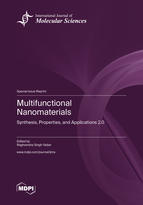Multifunctional Nanomaterials: Synthesis, Properties, and Applications 2.0
A special issue of International Journal of Molecular Sciences (ISSN 1422-0067). This special issue belongs to the section "Molecular Nanoscience".
Deadline for manuscript submissions: closed (15 February 2023) | Viewed by 30735
Special Issue Editor
Interests: magnetic materials; dielectric materials; electrical properties; luminescent nanomaterials; micro-wave absorbing materials; ceramics; materials chemistry; soft matter; nanostructured materials; materials for energy; semiconductor materials; nano-bio composite materials; metals and alloys; nanocomposites; functional materials; optical materials; graphene; polymer nanocomposites; graphene nanocomposites; graphene quantum dots; nanoparticles; structural properties; magnetic properties; dielectric properties; magnetically recoverable efficient photo-catalysts; data storage; gas sensing; magnetoresistance; other physical properties; synthesis; characterization; hyperthermia cancer treatment; drug delivery; magnetic resonance imaging (MRI) contrast agents; magnetic refrigeration (MR); spintronic devices; ferro-fluids; anode materials for Li-ion batteries; microwave devices; water splitting for hydrogen production; paint industry; super-capacitors; elect
Special Issues, Collections and Topics in MDPI journals
Special Issue Information
Dear Colleagues,
Multifunctional nanomaterials consist of smart nanoparticles with two or more engineered properties/characteristics. These multifunctional nanomaterials exhibit remarkable structural and physical properties, which have led to an increase in their industrial applications. In addition, biomolecules can be functionalized on the surface of nanoparticles for their potential applications in the biomedical field.
This Special Issue focuses on the development, characterization, and analysis of advanced multifunctional nanomaterials for various applications, including photocatalysts, anode materials for Li-ion batteries, supercapacitors, solar cells, photovoltaics, data storage, gas sensing, chemical sensors, biosensors, magnetoresistance, hyperthermia cancer treatment, drug delivery, magnetic resonance imaging (MRI) contrast agents, magnetic refrigeration (MR), spintronic devices, ferrofluids, microwave devices, water splitting for hydrogen production, the paint industry, electromagnetic interference shielding or microwave absorbers, etc.
For this Special Issue, we would like to invite researchers to contribute original research articles as well as review articles on ‘‘Multifunctional Nanomaterials’’ focusing on synthesis, properties, and applications.
Dr. Raghvendra Singh Yadav
Guest Editor
Manuscript Submission Information
Manuscripts should be submitted online at www.mdpi.com by registering and logging in to this website. Once you are registered, click here to go to the submission form. Manuscripts can be submitted until the deadline. All submissions that pass pre-check are peer-reviewed. Accepted papers will be published continuously in the journal (as soon as accepted) and will be listed together on the special issue website. Research articles, review articles as well as short communications are invited. For planned papers, a title and short abstract (about 100 words) can be sent to the Editorial Office for announcement on this website.
Submitted manuscripts should not have been published previously, nor be under consideration for publication elsewhere (except conference proceedings papers). All manuscripts are thoroughly refereed through a single-blind peer-review process. A guide for authors and other relevant information for submission of manuscripts is available on the Instructions for Authors page. International Journal of Molecular Sciences is an international peer-reviewed open access semimonthly journal published by MDPI.
Please visit the Instructions for Authors page before submitting a manuscript. There is an Article Processing Charge (APC) for publication in this open access journal. For details about the APC please see here. Submitted papers should be well formatted and use good English. Authors may use MDPI's English editing service prior to publication or during author revisions.
Keywords
- photocatalysis
- anode materials for Li-ion batteries
- photovoltaics
- sensors
- biomedical applications
- environmental applications
- energy storage applications
- energy harvesting applications
- biomolecules functionalized on the surface of nanoparticles







